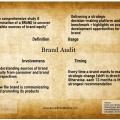5 Key Elements for a Stronger Brand Equity
 No doubt that most marketers want to have their brand as the foremost in the mind of their consumers when it comes to purchase decisions related to the category of their brands. One way to achieve that is through a well-structured Brand equity model that could bring you positive strategic returns.
No doubt that most marketers want to have their brand as the foremost in the mind of their consumers when it comes to purchase decisions related to the category of their brands. One way to achieve that is through a well-structured Brand equity model that could bring you positive strategic returns.
For example; an Armani wristwatch may not tell time better than a Swatch wristwatch, though, the adopted brand-building strategy by each brand makes it possible to achieve appropriate margins and profits), creating different Brand Stories among their consumers…and beyond.
When it comes to chosen brand elements (i.e. Brand Name, Logo, Symbol, Character, Packaging, Slogan…etc), experts found that successful brands across the globe are continuously maintaining distinct features that incorporated across their communication platforms. Those features are; Memorability, Meaningfulness, Appeal, Transferability, Adaptability and Protectability.
Following our advice of “OLD BUT GOLD”, we’d like to share one of the seminal brand building frameworks that had been developed by the famous marketing guru David Aaker more than 20 years back. His model placed the foundation for creating meaningful and salient brand equity that could stand the test of time.
Therefore, David Aaker’s “5 Key Elements for a Stronger Brand Equity” -which have been illustrated in a complete book- are:
1. Brand Loyalty
This could be a reflection of customer attachment to a brand when faced with competitive brands in terms of price, quality and repetitive purchase. A loyal customer sticks to a likable brand like glue and would hardly ever consider choosing another brand.
Hence Reduced marketing costs, higher profit, trade leverage and opportunity to lure new customers.
See also point (C), at “The Third Wave of Branding Evolution”
2. Brand Awareness
To establish awareness, consumers need to know who you are and what you do. As long as the consumer is aware of your existence, they will be able to recall and recognize your brand.
You could dominate consumers’ subconscious using different branding strategies, making them more comfortable to choose your brand among your competition.
Brand Awareness is an anchor to which other associations (point 4 below) can be attached. It creates familiarity-liking, signalling commitment making your brand worthy to be considered by consumers.
3. Perceived Brand Quality
This could be linked strongly to ‘reasons-to-by’ your products. The moment quality is attributed to a brand, other products associated with that brand will be perceived to have the same level of quality (e.g. iPhone lines have been produced with high quality, hence, consumers suspect that iPad lines have the same level of quality). Hence, Perceived quality contributes to build trust and sustainable brand equity.
4. Brand Association
Unique set of brand associations help consumer process and retrieve relative information about specific brand. It helps as a differentiator between competition, providing other complimentary reasons-to-buy, that could establish positive attitude toward the brand.
For instance, a brand could be associated to luxury life style and social groups (eg. Louis Vuitton), or to safety (eg. Volvo Cars), or to celebrity (eg. Ashton Kutcher and Lenovo Yoga Tablet), or to environmental responsibility (eg. IKEA).
Nevertheless, the main point here is to bear in mind that the stronger and meaningful your brand associations to consumers, the stronger and favourable your brand will be in their minds.
5. Proprietary Assets
These features add to the competitive advantage of your brand, as well as, the protection of your brand from competition over time. That includes patents, intellectual properties, established relationships and trademarks.
An Extra Tip!
To understand the current situation of your brand, its current health with regard to your market market, as well as possible development opportunities, then you’ll need to consider conducting a comprehensive BRAND AUDIT exercise.
References
David A, Aaker, Building Strong Brands (New York: Free Press, 1995).




